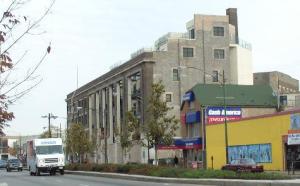1635 West Belmont Avenue
Built 1911
Architect: Robert C. Berlin
The Lincoln Theater, alternatively known as the Lincoln-Belmont Theater, opened in January 1912 as the first of two large theaters built near the crossroads of Lincoln, Belmont, and Ashland Avenues during Chicago’s Jazz Age.
Located south of Belmont between Ashland and Lincoln Avenues, the Lincoln was owned by department store merchant W.A. Wieboldt and constructed at a cost of $300,000. At the time of its opening, the theater was the most elegant and modern theater ever built on the city’s north side. Designed by Chicago architect Robert C. Berlin, the Lincoln was considered by many to be as grand as any theater in the city. “Upon entering the lobby,” reflected a local reporter, “one is immediately impressed with the metropolitan air of the place. The foyers are dignified in their simplicity and the decorative effects are exquisite in their beauty. The decorator has combined a kind of Persian pattern of ornamentation with the flowery lightness so characteristic of Japanese artists. There is not a trace of somberness nor gloom anywhere.”
Aside from its pretentiousness, the Lincoln was also a state-of-the-art theater. Its most admired features included 1,800 cushioned seats, technically superior acoustics, ample fire exits, and indirect lighting effects to reduce glare in the main auditorium. Also of note was the theater’s massive air-cooling system. It was capable of pumping 2.5 million cubic feet of fresh air into the theater every hour and, according to reports, greatly enhanced the theater-going experience. “After seeing a performance,” observed one visitor, “one arises from his seat not enervated, sleepy and tired, but refreshed, intellectually awake and reinvigorated.”

Lincoln Theater Building, October 2003
Built during an era of tremendous changes in the entertainment industry, the Lincoln was designed with both vaudeville, a declining form of amusement, and motion pictures in mind. The theater’s stage was 35 feet deep and 75 feet tall, roomy enough for just about any vaudeville act. But there was also a small room at the back of the balcony that housed a motion picture machine, with which movies could be projected onto a screen in front of the stage. During the 1910s and early 1920s, the Lincoln was part of the Orpheum Circuit, offering high-grade vaudeville acts booked by the Western Vaudeville Managers’ Association. However, movies became an increasingly regular feature at the theater during the 1920s.
In 1930, the theater shut down for three months to permit the city of Chicago to shave off the theater’s western wall to make room for the widening of Ashland Avenue. The project reduced the number of seats in the theater by about 350.
Parts of the theater building were converted into condominiums in 2000.
Sources: The Ravenswood Citizen, 20 Jan 1912, 11; Variety, 11 June 1930, 61.
Image source: Author’s collection
